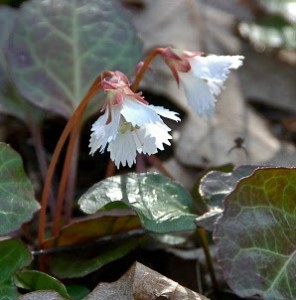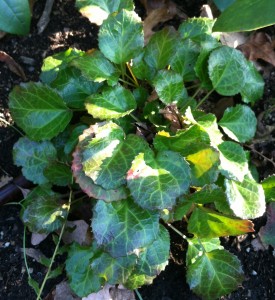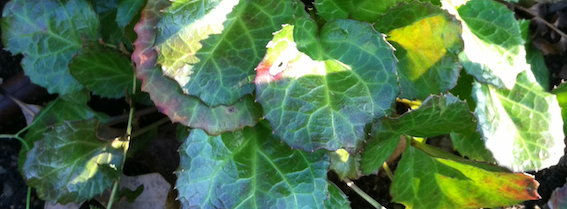Oconee Bells
Posted in Gardening Tips on December 25 2012, by Sonia Uyterhoeven
Sonia Uyterhoeven is the NYBG‘s Gardener for Public Education.

Oconee bells (Shortia galacifolia) is a rare and wonderful relative of the wandflower (Galax urceolata). Its foliage is a diminutive version of the wandflower’s, with glossy round leaves showing wavy margins and striking venation. These glistening leaves and the striking patterns within them remind me of a shiny crocodile handbag. I suppose I should say faux crocodile handbag to be politically correct. That, and the pattern of the veins is different.
However, the flower is otherwise completely different from the wandflower. Shortia has pinkish white, bell-shaped flowers with jagged edges that appear in early spring. This small woodland groundcover (growing 4 to 8 inches tall) is a must for any woodland aficionado. I must warn you that it is not the easiest woodland plant to grow, but once established, it will do fine in your garden.
Oconee bells are from Oconee County and its surrounding areas in South and North Carolina. The region is full of lakes, rivers, deeply wooded forests and hilly terrain. The name Oconee is a derivation of the Cherokee word Ae-quo-nee, which means “land beside water.”
The native habitats for this rare woodland beauty are stream banks and slopes in partial to full shade. It can often be found growing with rhododendron and other Ericaceous plants in damp, acidic soil. However, Shortia is not good with competition and requires a space of its own. Other woodland groundcovers, including its cousin, Galax, grow more vigorously and will crowd it for space.
Oconee bells spread slowly from shallow rhizomes that creep along the forest floor. The root system is initially very fine; once it is established, it will form deeper roots. For the gardener, this means that it is imperative not to let it dry out in the warm summer months. Over-fertilizing is equally hazardous for a plant with a sensitive root system. The best way to care for this woodlander is to provide a light layer of fine mulch in the spring that will keep the roots protected and add nutrients to the soil.

This plant is coveted in the trade not only for it rarity–it is found in a few areas in North and South Carolina and in isolated spots in Tennessee, Virginia and Georgia–or for its beauty. Beyond these qualities, it is a plant with a history–botanists and horticulturists alike always love a good story.
Shortia galacifolia was discovered by a Frenchman named André Michaux, a botanist who had spent eleven years collecting plants in the United States between the 1780s and ’90s. Michaux had stumbled across a colony of Shortia in the winter of 1788 and had collected its foliage and recorded it with a question mark–perhaps a new genus?
Fifty years later, the renowned American botanist Asa Gray traveled to Europe to examine American flora that had been collected throughout the previous century by European botanists. During his stay in Paris, he examined the herbarium collection of Michaux. He found an unfinished herbarium specimen that included sketchy notes as to the location of this plant. Immediately, Gray was hooked. Upon seeing the specimen, Gray decided that he needed to find this new genus, which he thought must be a relative of the wandflower–Galax.
Before he ever sets eyes on the plant, he named it Shortia galacifolia. The genus name was in honor of a respected Kentucky physician and botanist named Charles Wilkins Short; the species name literally means “foliage similar to Galax.” Finally, in 1841 and 1843, Gray traveled down to North and South Carolina in search of Shortia.
Unfortunately for Gray, the journal entries that Michaux had left behind gave few details of the plant’s exact location. He instead focused on the miserable, rainy winter weather, and the experience of taking shelter with a family of Native Americans in a crowded, smoky cabin. Gray was also set off course by a journal entry that referred to hautes montagnes de Carolinie (“high mountains of the Carolinas”). Gray set off into the mountains (Roan, Iron, and Grandfather) when he should have headed for the hills–specifically, the area surrounding Jorcassee Lake and the Keowee River.
Gray searched in vain. He wrote to Charles Short and provided him with directions and instructions, but the Kentuckian was also unable to find his namesake. Nearly forty years passed without a discovery of Shortia, even though the region was traversed by many noted botanists of the day.

In 1877, George McQueen Hyams, the seventeen-year-old son of an herbalist, discovered wild Shortia while out collecting with his father. They were unable to identify the specimen, so they sent it to a friend in East Greenwich, Rhode Island, who then passed the information along to Asa Gray. When Gray saw the Shortia, he exclaimed triumphantly, “My long faith rewarded at last!”
Gray organized an excursion to see the plant in flower early in the spring of 1879. Charles Sargent, a botanical friend of Gray’s, returned to the Carolinas in 1886 and rediscovered the original site that Michaux had encountered one hundred years earlier.
It is a beautiful story that illustrates the tenacity of botanists who practice their trade in the field. Finding Shortia in the Carolinas was like searching for the proverbial needle in the haystack when you think of the terrain that needed to be covered in order to find this rare flora. It elucidates the importance of assiduous documentation and the preservation of herbarium specimens.
It is also an important reminder that botany and the exploration of the natural world are collective activities best accomplished through networking and the exchange of information from a variety of communities. In the new year, I invite you to become involved at The New York Botanical Garden or in your own local community. Working toward the discovery and preservation of the natural world ensures that our future will be full of as much natural wonder as it was in previous centuries.
Happy holidays to all my readers.
Header photo by Natural Gardening.


Great article on Shortia! I must point out one mistake, though, concerning when Michaux made his shortia collection. It was mistakenly believed to be in December. However, a seed pod and leaves were found in the voucher of Michaux’s herbarium specimen by Asa gray. A seed pod of shortia would not have persisted into Winter. I believe the correct month of Michaux’s Shortia collection was in the month of June, based on the latest research.
Does the NYBG have Shortia galacifolia growing in the garden? If you would like some for the garden, I propagate these plants from seed and have them available. Thanks, Joe Townsend